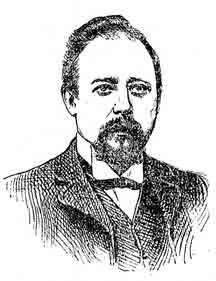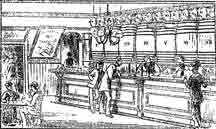Commissioner Alexander Steart Whyte.
Ye Olde Anchor Tavern, 21 Argyle Street, Glasgow.

Commissioner Whyte. 1888.
Commissioner Whyte was better known as an accountant than a publican. As Convener of the Govanhill Finance Committee, he was always on demand, constant requests for his service, as the taxpayers had to pay up.
At a Ward meeting in 1887 an extraordinary state of affairs came to light in the financing of the burgh accounts. Mr Whyte, who was one of the representatives of the East Ward and convener of the Finance Committee, expressed dissatisfaction with the form of the statement of accounts submitted on his taking office as convener the previous year and resolved to make a thorough investigation and to unravel what appeared to him to be a mysterious disappearance of a valuable asset.
The result was that an alarming and growing deficit was clearly brought out. Thoroughly convinced that his position was unassailable, he laid his statement before his brother Commissioners, a majority of whom, however, des credited their correctness; but after full, and at times heated, discussions he, as a test, demanded that his statement of accounts should be submitted to a qualified chartered accountant, whose decision he was prepared to submit to as final.
Mr Alexander Murray, C. A., the auditor of the burgh accounts, was chosen, and his report fully bore out all that Mr Whyte had asserted, and the Commissioners were brought to face the fact that there was a deficiency in the Police accounts at the end of the financial year in 1886 of £790 18 shillings 9 pence., which had increased to £881 10 shillings and a half penny in 1887. In order to bring out the position more clearly, he showed that a sum of £2,133 3 shillings and 4 pence., borrowed from the Royal Liver Society, was expended by the Commissioners of Police buildings.
By Act of Parliament the Commissioners were bound to provide for the repayment of this sum from revenue in installments of one-twentieth part yearly, and an arrangement was made with that society in these terms, so that at the end of 20 years the building would become the property of the burgh free of debt.
In order to provide for this an arrangement was entered into with the County Commissioners, whereby that body took a lease of the premises for 20 years, at a rent to cover interest, fen-duties, fire insurance, and one-twentieth of the capital, thus giving a free asset of £106 13 shillings 2 pence, annually to the burgh; but he was surprised to find that this asset was never accounted for. He found that the surplus which should have appeared in their buildings' account as a free asset had been appropriated, or perhaps borrowed, for the Police accounts, and this had been going on for the last seven years.
It only remains to be said that Provost Hunter was in entire accord with Mr Whyte, and publicly announced at a ward meeting that they were willing to have the accounts placed in the hands of any qualified chartered accountant, and, if their position was not entirely maintained as the only correct one, they would pay £10 to be given to the poor of Govanhill, provided their challengers, if such could be found, would undertake to be the same if the contrary was proved. This is but part of the good work he had accomplished for the burgh, and it is an open secret he is to run for Bailie at the next election, as on the last occasion he was returned by the greatest majority of any Commissioner.
Mr Whyte's career as a publican was very short. Ye Olde Anchor Tavern was refurbished when he took over the business. The walls were panelled with beaded teak wood, with tiles denoting the seasons running on top, giving the interior a light clean appearance. The snug's were similarly panelled, with mahogany tables and upholstered leather seating. The "Meridian" room faced Argyle Street and was very popular with the customers, watching the world go by. The history of the tavern goes back to 1788, the tavern was reached through a close, old men in 1893 still recalled seeing Sir Hew Pollok riding on horseback right up to the door.

Interior view of Ye Olde Anchor Tavern. 1888.
The cellars had nine different compartments stocked with the best whisky and ale available at the time including wines and brandies of 1869. All the firms bottling was done here. Long John was a great favourite of Mr Whyte's as was Cameron Bridge and Glen Ochil. Another new feature of the old tavern was electricity and electric bells in the sitting rooms.
Mr Whyte was born in Glasgow in the 1840s, his grandfather was a native of Appin. Mr Whyte studied Philosophy and Chemistry.
Mr Robert Clachan Kerr was manager of Ye Olde Anchor Tavern in 1888,, he gained his experience and management with George McCallum's Eunson's Cafe Royal, 311 Argyle Street. Mr McCallum also owned the Caley Bar at the corner of Castle Street and Charles Street and the Artisan, Garngad Road better known as the Big Glen.
Manager Robert Kerr went on to become licensee of Ye Olde Anchor Tavern, his wife Marion took over the business after Roberts death in 1900. A few years later the old pub was closed down however Marion took over another pub at 193 Paisley Road which sat at the corner of Crookston Street, until the end of the First World War.
End.
